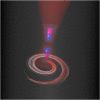Direct detection of photoinduced magnetic force at the nanoscale reveals magnetic nearfield of structured light
- PMID: 36351014
- PMCID: PMC9645709
- DOI: 10.1126/sciadv.add0233
Direct detection of photoinduced magnetic force at the nanoscale reveals magnetic nearfield of structured light
Abstract
We demonstrate experimentally the detection of magnetic force at optical frequencies, defined as the dipolar Lorentz force exerted on a photoinduced magnetic dipole excited by the magnetic component of light. Historically, this magnetic force has been considered elusive since, at optical frequencies, magnetic effects are usually overshadowed by the interaction of the electric component of light, making it difficult to recognize the direct magnetic force from the dominant electric forces. To overcome this challenge, we develop a photoinduced magnetic force characterization method that exploits a magnetic nanoprobe under structured light illumination. This approach enables the direct detection of the magnetic force, revealing the magnetic nearfield distribution at the nanoscale, while maximally suppressing its electric counterpart. The proposed method opens up new avenues for nanoscopy based on optical magnetic contrast, offering a research tool for all-optical spin control and optomagnetic manipulation of matter at the nanoscale.
Figures





Similar articles
-
Nearfield observation of spin-orbit interactions at nanoscale using photoinduced force microscopy.Sci Adv. 2024 Dec 20;10(51):eadp8460. doi: 10.1126/sciadv.adp8460. Epub 2024 Dec 20. Sci Adv. 2024. PMID: 39705359
-
Exclusive Magnetic Excitation Enabled by Structured Light Illumination in a Nanoscale Mie Resonator.ACS Nano. 2018 Dec 26;12(12):12159-12168. doi: 10.1021/acsnano.8b05778. Epub 2018 Dec 10. ACS Nano. 2018. PMID: 30516951
-
Linear and Nonlinear Optical Spectroscopy at the Nanoscale with Photoinduced Force Microscopy.Acc Chem Res. 2015 Oct 20;48(10):2671-9. doi: 10.1021/acs.accounts.5b00327. Epub 2015 Oct 9. Acc Chem Res. 2015. PMID: 26449563
-
Optomagnetic biosensors: Volumetric sensing based on magnetic actuation-induced optical modulations.Biosens Bioelectron. 2022 Nov 1;215:114560. doi: 10.1016/j.bios.2022.114560. Epub 2022 Jul 11. Biosens Bioelectron. 2022. PMID: 35841765 Review.
-
Nanophotonic Platforms for Chiral Sensing and Separation.Acc Chem Res. 2020 Mar 17;53(3):588-598. doi: 10.1021/acs.accounts.9b00460. Epub 2020 Jan 8. Acc Chem Res. 2020. PMID: 31913015 Review.
Cited by
-
Nanoscopic Observation of Chiro-Optical Force.Nano Lett. 2023 Oct 25;23(20):9347-9352. doi: 10.1021/acs.nanolett.3c02534. Epub 2023 Oct 4. Nano Lett. 2023. PMID: 37792311 Free PMC article.
-
Advances and challenges in dynamic photo-induced force microscopy.Discov Nano. 2024 Nov 21;19(1):190. doi: 10.1186/s11671-024-04150-1. Discov Nano. 2024. PMID: 39572421 Free PMC article. Review.
-
Thermal Sight: A Position-Sensitive Detector for a Pinpoint Heat Spot.Small Sci. 2024 Jul 11;4(8):2400091. doi: 10.1002/smsc.202400091. eCollection 2024 Aug. Small Sci. 2024. PMID: 40212558 Free PMC article.
-
Gradient and curl optical torques.Nat Commun. 2024 Jul 24;15(1):6230. doi: 10.1038/s41467-024-50440-8. Nat Commun. 2024. PMID: 39043631 Free PMC article.
-
Surface-phonon-polariton-enhanced photoinduced dipole force for nanoscale infrared imaging.Natl Sci Rev. 2024 Mar 18;11(5):nwae101. doi: 10.1093/nsr/nwae101. eCollection 2024 May. Natl Sci Rev. 2024. PMID: 38698902 Free PMC article.
References
-
- Pendry J. B., Negative refraction makes a perfect lens. Phys. Rev. Lett. 85, 3966–3969 (2000). - PubMed
-
- Pendry J. B., Aubry A., Smith D. R., Maier S. A., Transformation optics and subwavelength control of light. Science 337, 549–552 (2012). - PubMed
-
- Kasperczyk M., Person S., Ananias D., Carlos L. D., Novotny L., Excitation of magnetic dipole transitions at optical frequencies. Phys. Rev. Lett. 114, 163903 (2015). - PubMed
-
- Neugebauer M., Eismann J. S., Bauer T., Banzer P., Magnetic and electric transverse spin density of spatially confined light. Phys. Rev. X 8, 021042 (2018).

